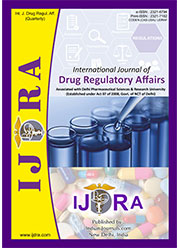Bioequivalence requirements of Pharmaceutical Products in US, Europe and Australia
Abstract
In the last three decades, the notion of bioequivalence has gotten a lot of attention as it has been applied to new branded and generic medications. Generic medications must meet the same quality, efficacy, and safety requirements. Conventional products should be therapeutically equal to the reference product and compatible. The evolution of regulatory standards for bioequivalence in the United States, Europe, and Australia are examined in this paper. There is no international harmonization of regulatory requirements for bioequivalence, but the scope of bioequivalence and statistical analysis is partially harmonized; however, there are differences in applying single-dose trials and in vitro dissolution tests due to subject selection and reference product selection. The drug management system and drug regulating laws determine the pharmaceutical market's share. A bioequivalence study is one of the essential elements in the generic medicine approval process. The plasma time-concentration curve is frequently used in bioequivalence studies to determine absorption pace and absorption. The bioequivalence of the goods examined can be determined using the selected pharmacokinetic parameters and predefined acceptability thresholds. Recent advancements and information on crucial areas of bioequivalence study design and specification recommendations for each endpoint are included in this review.
Downloads
References
2. Kaushal N, Singh SK, Gulati M, Vaidya Y, Kaushik M. Study of regulatory requirements for the conduct of bioequivalence studies in US, Europe, Canada, India, ASEAN and SADC countries: impact on generic drug substitution. Journal of Applied Pharmaceutical Science. 1930 Jan 11;6(4):206-22.
3. Galgatte UC, Jamdade VR, Aute PP, Chaudhari PD. Study on requirements of bioequivalence for registration of pharmaceutical products in USA, Europe, and Canada. Saudi Pharmaceutical Journal. 2014 Nov 1;22(5):391-402.
4. García-Arieta A, Gordon J. Bioequivalence requirements in the European Union: critical discussion. The AAPS journal. 2012 Dec;14(4):738-48.
5. Guideline IH. Biopharmaceutics classification system-based biowaivers M9. Int Counc Harmon Tech Requir Pharm Hum Use. 2018 Jun 7:19.
6. Chisholm O, Sharry P, Phillips L. Multi-Criteria Decision Analysis for Benefit-Risk Analysis by National Regulatory Authorities. Frontiers in Medicine. 2021;8.
7. De Vlieger JS, Crommelin DJ, Tyner K, Drummond DC, Jiang W, McNeil SE, Neervannan S, Crist RM, Shah VP. Report of the AAPS guidance forum on the FDA draft guidance for industry: "drug products, including biological products, that contain nanomaterials."
8. Mastan S, Latha TB, Ajay S. The basic regulatory considerations and prospects for conducting bioavailability/bioequivalence (BA/BE) studies-an overview. Comp Eff Res. 2011 Mar 22;1:1-25.
9. Chen ML, Shah V, Patnaik R, Adams W, Hussain A, Conner D, Mehta M, Malinowski H, Lazor J, Huang SM, Hare D. Bioavailability and bioequivalence: an FDA regulatory overview. Pharmaceutical research. 2001 Dec;18(12):1645-50.
10. Soulele K, Macheras P. Clinical Evaluation–In Vivo Bioequivalence Assessment of MR Formulations. Oral Drug Delivery for Modified Release Formulations. 2022 Apr 20:391-408.
11. Yazdanian M, Briggs K, Jankovsky C, Hawi A. The "high solubility" definition of the current FDA guidance on biopharmaceutical classification system may be too strict for acidic drugs. Pharmaceutical research. 2004 Feb;21(2):293-9.
12. European Medicines Agency. Guideline on the investigation of bioequivalence. European Medicines Agency; 2010 Jun 20.

This work is licensed under a Creative Commons Attribution-NonCommercial 4.0 International License.
The International Journal of Drug Regulatory affairs require a formal written transfer of copyright from the author(s) for each article published. We therefore ask you to complete and return this form, retaining a copy for your records. Your cooperation is essential and appreciated. Any delay will result in a delay in publication.
I/we have read and agree with the terms and conditions stated Page 2 of this agreement and I/we hereby confirm the transfer of all copyrights in and relating to the above-named manuscript, in all forms and media, now or hereafter known, to the International Journal of Drug Regulatory affairs, effective from the date stated below. I/we acknowledge that the IJDRA is relying on this agreement in publishing the above-named manuscript. However, this agreement will be null and void if the manuscript is not published in the IJDRA.
Download link for COPYRIGHT FORM







